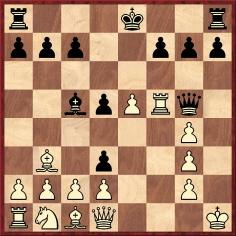
Edward Winter
In C.N. 954 (published in 1985) Paul Timson (Whalley, England) reported that as part of a series of programmes entitled ‘Miniature Chess Masterpieces’ Granada TV had shown a game said to have been played between Adolf Anderssen and Max Lange in Breslau, 1859:
1 e4 e5 2 Nf3 Nc6 3 Bb5 Nd4 4 Nxd4 exd4 5 Bc4 Nf6 6 e5 d5 7 Bb3 Bg4 8 f3 Ne4 9 O-O d3 10 fxg4 Bc5+ 11 Kh1 Ng3+ 12 hxg3 Qg5 13 Rf5

13...h5 14 gxh5 Qxf5 15 g4 Rxh5+ 16 gxh5 Qe4 17 Qf3 Qh4+ 18 Qh3 Qe1+ 19 Kh2 Bg1+ 20 Kh1 Bf2+ 21 Kh2 Qg1 mate.
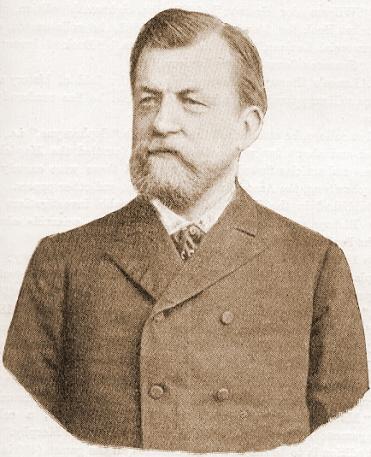
Max Lange
Mr Timson commented to us:
‘After the programme was over, I tried to find the score. Needless to say, the game is not included in the Oxford Encyclopedia, although six other games between Anderssen and Lange are given as played at Breslau in 1859. However, the game does appear in Reinfeld’s Great Short Games of the Chess Masters, where it is stated that White resigned after Black’s 18th move. The same score is in The Golden Treasury of Chess. But in du Mont’s 200 Miniature Games of Chess the finish is given as 15...Qf2 16 White resigns. Finally, in Wenman’s 175 Chess Brilliancies the game is said to end 15...Qf2 16 g3 Qxd3 17 Qf1 Qxg4 18 White resigns.
I should be very interested to learn:
a) Was this a genuine game or merely analysis between the players?
b) What is the original score of the game?
c) If it is a genuine game, what is the correct score?’
On page 269 of Chess Explorations we offered some further references:
‘A 1913 book, Memorable Chess Games, Brilliants, and Miniatures, with Notes, Queries, and Answers asserted (page 16) that the game had taken the course later given by Wenman and had continued 18 Qxf7+ Kxf7 19 Bxd5+ Ke7 20 Bg2 Qh4+ 21 Bh3 Qxh3 mate. The same moves were provided by Mason on page 143 of an earlier (1900) work, Social Chess, although the game was merely headed ‘Won by Dr Max Lange’. Mason awarded an exclamation mark to 15...Qf2 but also, in the notes, to 15...Rxh5+. He called the latter line, which he followed through to 21...Qg1 mate, “another and perhaps prettier way of winning”.’

Adolf Anderssen
A further complication was put forward in C.N. 3412, which mentioned that although the game was not included in H. von Gottschall’s monograph on Anderssen, it did appear (with the conclusion 13...h5 14 White resigns) on pages 278-279 of Schachjahrbuch für 1917/18 by L. Bachmann (Ansbach, 1919) with Anderssen’s opponent (Black) named as Jean Dufresne and the occasion given as ‘Berlin, Zeit unbekannt (1851?)’.
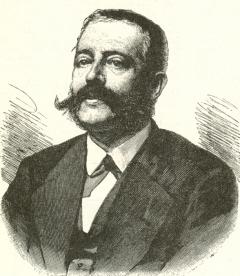
Jean Dufresne
In C.N. 3885 Toni Preziuso (Chur, Switzerland) reported that Emanuel Lasker’s chess column in the Vossische Zeitung of 11 August 1918 had the same version as in Bachmann’s Schachjahrbuch 1917/18 (which, as noted above, was published in 1919), and that it was presented as Anderssen v Dufresne but without any venue or date. The score ended ‘13...h5 and wins’.
Mr Preziuso added that the source indicated by Lasker was a recent column by Nimzowitsch in the Baltische Zeitung, and that Nimzowitsch had obtained the game from Max Harmonist:
‘Wir entnehmen die folgende Partie der Baltischen Zeitung. Der Leiter von deren Schachspalte, Meister Niemzowitsch, hatte sie vor Jahren von Harmonist erhalten und übergab sie kürzlich der Öffentlichkeit.’
Our correspondent commented:
‘That does not clear up the questions about this mysterious Anderssen game but it does, I think, show the provenance of the game-score in Bachmann’s Schachjahrbuch.’
Shortly afterwards, in C.N. 3888, Peter Anderberg (Harmstorf, Germany) quoted from Nimzowitsch’s column in the Baltische Zeitung, 5 June 1918, page 5:
‘Eine Glanzpartie.
Folgende wenig bekannte, überaus glänzend durchgeführte Partie soll – so lautet wenigstens die mündliche Überlieferung – zwischen den älteren Meistern Anderssen und Dufresne gespielt worden sein; da indes geschichtliche Daten fehlen, so geben wir die Namen der Spieler unter Vorbehalt wieder. Die Partie selbst ist dem jetzigen Redakteur dieser Rubrik und Schreiber dieser Zeilen vor vielen Jahren (1902) von dem inzwischen verstorbenen Meister Harmonist – Berlin freundlichst mitgeteilt worden. Wir glauben nicht, daß sie bereits veröffentlicht sei.’
Then followed the game-score of ‘Anderssen v Dufresne’, with the final moves given as 14 gxh5 Qxf5 15 g4 Qf2 16 g3 Qxg3 17 Qf1 Qxg4 0-1.
Thus Nimzowitsch exercised care, stating that it was merely an ‘oral tradition’ that the game had been played between Anderssen and Dufresne. He also specified that the score, which he believed to be previously unpublished, had been shown to him by Harmonist in 1902.
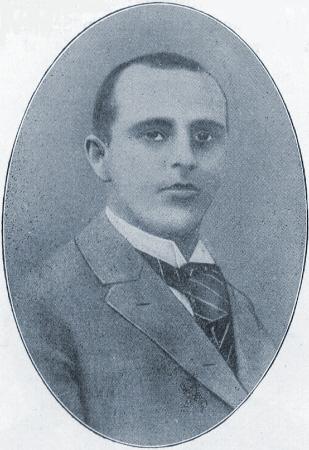
Max Harmonist
Mr Anderberg also mentioned that Max Lange himself had published this game as ‘Anderssen v Lange, Breslau, 1859’ on page 217 of his book Der Meister im Schachspiel (Weimar, 1881), with the finish 21 Bh3 Qxh3 mate, as was pointed out by Hans Ellinger of Tübingen, Germany on page 57 of issue 13 of Kaissiber.
As regards the twentieth-century publication of the game, Mr Anderberg suggested the following as the likely historical sequence:
‘1. In old age Dufresne showed Harmonist this game, around 1890 – “an Anderssen loss”.
2. In 1902 Harmonist showed the game to Nimzowitsch (a student in Berlin) – “an Anderssen loss, handed down by Dufresne”.
3. Nimzowitsch published the game with the proviso that the players’ names were dubious.
4. Lasker removed all trace of doubt about the game’s authenticity.
5. Finally, Bachmann made up “Berlin, 1851?”.’
In that same C.N. item Toni Preziuso also drew attention to Max Lange’s book Der Meister im Schachspiel and provided the relevant text from page 217:
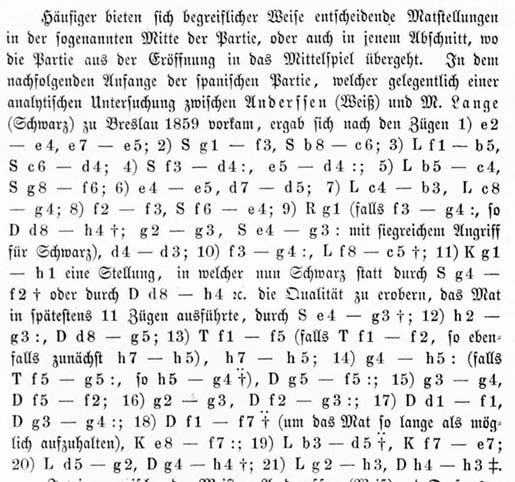
Lange wrote, in particular:
‘In dem nachfolgenden Anfange der spanischen Partie, welcher gelegentlich einer analytischen Untersuchung zwischen Anderssen (Weiss) und M. Lange (Schwarz) zu Breslau 1859 vorkam, ergab sich nach den Zügen ...’
Mr Preziuso commented in conclusion:
‘So it is clear that it was an “analytical exploration” between Anderssen and Lange in Breslau in 1859.’
This article originally appeared at ChessBase.com.
To the Chess Notes main page.
To the Archives for other feature articles.
Copyright: Edward Winter. All rights reserved.